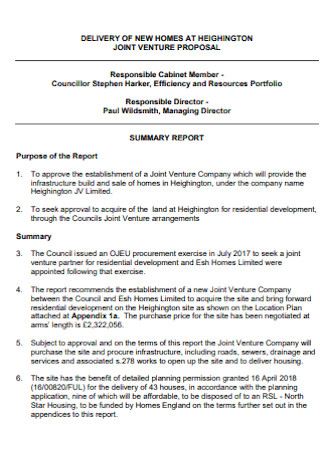10+ Sample Joint Venture Proposals
-

Joint Venture Project Proposal
download now -

Transportation Joint Venture Proposal
download now -

Commercial Joint Venture Proposal
download now -

Joint Venture Proposal for Power Plant
download now -

Home Joint Venture Proposal
download now -

Joint Venture Proposal Form
download now -

Joint Venture Proposal Sheet
download now -

Sample Joint Venture Proposal
download now -

Joint Venture Request Proposal
download now -

Joint Venture Project Proposal Template
download now -

Harvest by Joint Venture Proposal
download now
FREE Joint Venture Proposal s to Download
10+ Sample Joint Venture Proposals
What Is a Joint Venture Proposal?
What’s Inside a Joint Venture Proposal?
How to Prepare a Joint Venture Proposal
FAQs
Is an exit strategy important when entering a joint venture?
What is an example of a joint venture type?
What is the difference between a joint venture and a consortium?
What Is a Joint Venture Proposal?
Before we define what the proposal document is, we need to be familiarized with what a joint venture is all about. A joint venture is defined as a commercial partnership wherein two or more parties agree to combine their resources in order to complete a certain job. This assignment might be a new project or something else entirely. Shared ownership, shared returns and risks, and shared governance is all characteristics of this form of company setup. Business expansion, product development, and expansion into new markets, particularly internationally, are all common motivations for joining a joint venture. Despite the fact that the venture is its own separate entity, each of the members is liable for its earnings, losses, and expenditures.
A joint venture proposal is a business document that a particular company (whether it is already established or still a startup) prepares to send to another company in the hopes of forming a joint venture. Because the concept involves two distinct organizations collaborating, it may include aspects such as collaborating to develop a certain product or doing the entire business jointly. This proposal is a chance for the firm to advertise itself and persuade the other company of the benefits that the joint venture may provide. Additionally, this proposal can serve as a huge deciding factor in the planned joint venture deal between the companies involved.
What’s Inside a Joint Venture Proposal?
Here are the key components that should be written down when preparing a joint venture proposal to make this document effective:
How to Prepare a Joint Venture Proposal
As stated earlier, a joint venture proposal can make or break the chances of the parties involved pushing through with the deal, which is why it must be written thoroughly. With that being said, here are the steps to be followed in order to effectively prepare a joint venture proposal:
1. Perform a Research
This is the first step to be followed and usually takes place even before preparing the document. In this step, to establish whether or not a possible joint venture partner is a good fit, do thorough research on them. The proposal should demonstrate that the person reaching out is aware of who they are, has done their research, and has determined that they are the right fit. This not only proves the project’s appropriateness but also that the party reaching out is someone worth collaborating with.
2. Explain Intended Outcomes
After performing research on the other party and determining that they’re a good fit, it’s time to reach out to them. The first thing to do when reaching out is to explain the intended outcomes of the proposal. When describing the desired outcome and aims, describe them in terms of benefits. Explain not only what the initiative will accomplish, but what it will mean for their company. The target party should be able to see how the joint venture project will benefit them. It’s also worth mentioning how the joint venture initiative will benefit both parties.
3. Outline the Key Details
After providing an explanation of the intended outcomes of the joint venture project, it’s time to outline the key details. Some of the key details of the joint venture proposal include the scope and the objectives. When outlining the key details, as much as feasible, describe them in detail. At the very least, include a summary of the project’s objectives. Explain any details that have already been decided or are critical to the project in addition to the overall concept. Many things may be worked out later once they’ve agreed, but make a list of everything that’s essential to them so they can determine if the project is suitable for them.
4. Outline the Action Plans and Budget
The next step to be done after outlining the key details of the joint venture proposal is to outline the action plans and budget. In this step, provide thorough action plans and integrate them with the key individuals, as well as practices, in accordance with the joint venture’s common goal. As critical solutions to potential challenges on the joint venture project are considered, communicate effectively with each member. Also, include any required details regarding the joint venture’s expected budget.
5. Anticipate Questions
After providing the action plans and budget of the joint venture proposal, it’s time to proceed to this step, which also serves as the last one. In this step, Anticipate any questions the other party may have and respond to them in the proposal before they have a chance to ask them. This will save time and make deciding whether or not to participate easier for them. Take a moment to consider any possible concerns they may have and address them as well.
FAQs
Is an exit strategy important when entering a joint venture?
Yes, it is. As the project goals are met throughout the joint venture, the business relationship then ends. In a joint venture, having an exit strategy is critical because it lays out a clear path for dissolving the joint venture, avoiding lengthy talks, costly legal fights, unfair tactics, bad consumer effects, and potential financial loss.
What is an example of a joint venture type?
An example of a type of joint venture is a project-based joint venture. Companies form this sort of joint venture to accomplish a specified job, such as the execution of a certain project or a specific service to be delivered together, to complete an assignment, and so on. Such collaboration is often performed between organizations for a single, specified goal, and as a result, it ends after the project is accomplished.
What is the difference between a joint venture and a consortium?
The fundamental distinction between a consortium and a joint venture is that a consortium is often thought of as a looser arrangement involving organizations that are still clearly distinct. The entities work together on a project—for example, construction firms constructing an office building—but have little influence over one another.
Whenever companies enter a joint venture, they are afforded access to the resources of the other company without the burden of having to spend exorbitant amounts of funds. Additionally, each company involved maintains its identity and can go back to its normal individual operations after the venture has been finished. Having a properly written proposal is key to the companies pushing through with the project, and in this article, there are plenty of examples that you can have a look at whenever you need help in creating this document.
